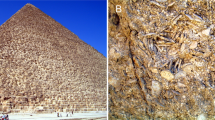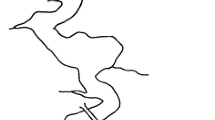Abstract
This study investigates spatio-temporal variations of in situ division rate (μ) of two species of the genus Dinophysis. Based on a postmitotic index approach, estimates of μ from net-haul samples were compared during five daily cell cycles studies in three stations of the Punic harbors of Carthage (Gulf of Tunis). To study the annual cycle of Dinophysis spp., weekly sampling were carried out from March 2008 to June 2010. In addition, sampling over 24 h was conducted on three-cycle studies in late spring and two-cycle studies in autumn, seasons characterized by Dinophysis proliferations. We recorded important abundances of Dinophysis sacculus stein (2.25 × 104 cells/l, June 2008) and Dinophysis cf. acuminata (3 × 104 cells/l, June 2009). Cellular division was phased in D. sacculus stein and D. cf. acuminata, but the division time, required for the population cohorts to pass from one phase to another, and values of estimated division rates varied between seasons and stations for the same species. D. cf. acuminata exhibit moderate (0.22 day−1) to high (0.68 day−1) value of μ. In contrast, D. sacculus shows very low μ values (0.02–0.17 day−1) in autumn season to moderate values (0.21–0.35 day−1) in late spring. The results presented here confirm that the postmitotic index approach allowed estimated of μ at low field depths and concentrations (102–103 cells/l).
















Similar content being viewed by others
References
Aissaoui, A., Turki, S., Akrout, F. & Sammari, C. (2007). Toxic planktonic microalgae in Punic harbors of Carthage. Proceedings of the 8th Edition of TJASSST, 12–18.
Andersen, P., & Throndsen, J. (2004). Estimating cell numbers. In G. M. Hallegraeff, D. M. Anderson, & A. D. Cembella (Eds.), Manual on harmful marine microalgae. Monographs on oceanographic methodology (pp. 99–130). Paris: UNESCO.
Armi, Z., Turki, S., Trabelsi, E., & Ben Maïz, N. (2008). Nutrient loading and occurrence of potentially harmful phytoplankton species in the North Lake of Tunis (Tunisia). Cahiers de Biologie Marine, 49, 311–321.
Armi, Z., Turki, S., Trabelsi, E., Ceredi, A., Riccardi, E., & Milandri, A. (2011). Occurrence of diarrhetic shellfish poisoning (DSP) toxins in clams (Ruditapes decussatus) from Tunis north lagoon. Environmental Monitoring and Assessment. doi:10.1007/s10661-011-2324-z.
Aubry, F. B., Berton, A., Bastianini, M., Bertaggia, R., Baroni, R., & Socal, G. (2000). Seasonal dynamics of Dinophysis in coastal waters of the NW Adriatic Sea (1990–1996). Botanica Marina, 43, 423–430.
Batifoulier, F., Lazure, P., Velo-Suárez, L., Maurer, D., Bonneton, P., Charria, G., Dupuy, C. & Gentien, P. (2012). Distribution of Dinophysis species in the Bay of Biscay and possible transport pathways to Arcachon Bay. Journal of Marine Systems, 109–110, S273–S283.
Bennouna, A., Assobhei, O., Berland, B., & El Attar, J. (2000). Étude des populations phytoplanctoniques de la lagune de Oualidia (Maroc); dinoflagellés potentiellement nuisibles. Study of phytoplankton populations of Oualidia Lagoon (Morocco); potentially harmful dinoflagellates. Marine Life, 10, 3–18.
Bravo, I., Delgado, M., Fraga, S., Honsell, G., Lassus, P., Montresor, M. & Sampayo, M. A. (1995). The Dinophysis genus: Toxicity and species definition in Europe. In P. Lassus, G. Arzul, E. Erard, P. Gentien & C. Marcaillou (Eds.), Harmful marine algal blooms. Technique et Documentation-Lavoisier, Intercept Ltd, (pp. 843–845). Technique et Documentation-Lavoisier, Intercept Ltd.
Cabrini, M., Cok, S., Nichetto, P., Sidari, L., & Honsell, G. (1993). The genus Dinophysis (Dinophyceae) in the gulf of Trieste (Northern Adriatic Sea). Giornale Botanico Italiano, 127, 835–837.
Campbell, L., Olson, R. J., Sosik, H. M., Abraham, A., Henrichs, D. W., Hyatt, C. J., et al. (2010). First harmful Dinophysis (Dinophyceae, Dinophysiales) bloom in the US is revealed by automated imaging flow cytometry. Journal of Phycology, 46, 66–75.
Caroppo, C. (2001). Autoecology and morphological variability of Dinophysis sacculus (Dinophyceae: Dinophysiaceae) in a Mediterranean lagoon. Journal of the Marine Biological Association of the United Kingdom, 81, 11–21.
Carpenter, E. J., & Chang, J. (1988). Species-specific phytoplankton growth rates via diel DNA synthesis cycles. I. Concept of the method. Marine Ecology Progress Series, 43, 105–111.
Claparède, É., & Lachmann, J. (1859). Études sur les infusoires et les rhizopodes. Mémoire de l’Institut Européen de Genève, 6, 261–482.
Delgado, M, Garcés, E, Camp, J. (1996). Growth and behaviour of Dinophysis sacculus from NW Mediterranean. In T. Yasumoto, Y. Oshima & Y. Fukuyo (Eds.), Harmful and toxic algal blooms (pp. 261–264). Sendai: Intergovernmental Oceanographic Commission of UNESCO.
Dimitra, P., Aligizaki, K., Nikolaidis, G. (2010). Exploring the identity of the Greek Dinophysis cf. acuminata. Harmful Algae, 10, 1–8.
EL Madani, F., Chiaar, A., & Chafi, A. (2011). Phytoplankton composition and abundance assessment in the Nador lagoon (Mediterranean coast of Morocco). Acta Botinica Croatia, 70, 269–288.
Frehi, H., Couté, A., Mascarell, G., Perrette-Gallet, C., Ayada, M., & Kara, M. H. (2007). Dinoflagellés toxiques et/ou responsables de blooms dans la baie d’Annaba (Algérie). Comptes Rendus Biologies, 330, 615–628.
Garcés, E., Delgado, M., & Camp, J. (1997). Phased cell division in natural population of Dinophysis sacculus and the in situ measurement of potential growth rate. Journal of Plankton Research, 19, 2067–2077.
Giacobbe, M. G. (1995). Morphological observations on Dinophysis species (Dinophyceae) from Mediterranean coastal waters. Cryptogamie, Algologiya, 16, 233–245.
Jacobson, D. M., & Andersen, R. A. (1994). The discovery of mixotrophy in photosynthesic species of Dinophysis (Dinophyceae): light and electron microscopical observations of food vacuoles in Dinophysis acuminata, D. norvegica and two heterotrophic dinophysoid dinoflagellates. Phycologia, 33, 97–110.
Jaén, D., Mamán, L., Domínguez, R., & Martín, E. (2009). First report of Dinophysis acuta in culture. Harmful Algae News, 39, 1–2.
Janson, S. (2004). Molecular evidence that plastids in the toxin-producing dinoflagellate genus Dinophysis originate from the free-living cryptophyte Teleaulax amphioxeia. Environmental Microbiology, 6, 1102–1106.
Jorgensen, E. (1923). Mediterranean Dinophysiaceae. Report on the Danish oceanographical expeditions 1908-10 to the Mediterranean, 2, 1–48.
Kacem, I., Hajjem, B., & Bouaïcha, N. (2009). First evidence of okadaic acid in Mytilus galloprovincialis mussels, collected in a Mediterranean Lagoon, Tunisia. Bulletin of Environmental Contamination and Toxicology, 82, 660–664.
Kim, S., Kang, Y. G., Kim, H. S., Yih, W., Coats, D. W., & Park, M. G. (2008). Growth and grazing responses of the mixotrophic dinoflagellate Dinophysis acuminata as functions of light intensity and prey concentration. Aquatic Microbial Ecology, 51, 301–310.
Koukaras, K., & Nikolaidis, G. (2004). Dinophysis blooms in Greek coastal waters (Thermaikos Gulf NW Aegean Sea). Journal of Plankton Research, 26, 445–457.
Larsen, J., & Moestrup, Ø. (1992). Potentially toxic phytoplankton. 2 Genus Dinophysis (Dinophyceae). In J. A. Lindley (Ed.), ICES Identification Leaflets for Plankton. Copenhagen: ICES. 12 p.
Lassus, P., & Bardouil, M. (1991). Le Complexe Dinophysis acuminata: identification des espèces le long des côtes Françaises. Cryptogamie Algologiya, 12, 1–9.
Lassus, P., Bardouil, M., Truquet, I., Truquet, P., Le Baut, C., & Pierre, M. J. (1985). Dinophysis acuminata distribution and toxicity along the southern Brittany coast (France): Correlation with hydrological parameters. In D. M. Anderson, A. W. White, & D. G. Baden (Eds.), Toxic dinoflagellates (pp. 159–162). New York: Elsevier/North Holland.
Marasović, I., Ninćević, Z., Pavela-Vranćid, M., & Orhanović, S. N. (1998). A survey of shellfish toxicity in the Central Adriatic Sea. Journal of the Marine Biological Association of the United Kingdom, 78, 745–754.
Margalef, R. (1975). Assessment of the effected on plankton. In E. A. Pearson & O. Frangipane (Eds.), Marine pollution and marine waste disposal (pp. 301–306). Oxford: Pergamon.
McDuff, R. E., & Chisholm, S. W. (1982). The calculation of in situ growth rates of phytoplankton populations from fractions of cells undergoing mitosis: A clarification. Limnology and Oceanography, 27, 783–788.
Nagai, S., Nishitani, G., Tomaru, Y., Sakiyama, S., & Kamiyama, T. (2008). Predation by the toxic dinoflagellate Dinophysis fortii on the ciliate Myrionecta rubra and observation of sequestration of ciliate chloroplasts. Journal of Phycology, 44, 909–922.
Nikolaidis, G., & Moustaka-Gouni, M. (1990). The structure and the dynamics of phytoplankton assemblages from the inner part of Thermaikos Gulf, Greece. I. Phytoplankton composition and biomass from May 1988 to May 1989. Helgoland Meeresunters, 44, 487–501.
Nishitani, G., Nagai, S., Sakiyama, S., & Kamiyama, T. (2008a). Successful cultivation of the toxic dinoflagellate Dinophysis caudata (Dinophyceae). Plankton Benthos Research, 3, 78–85.
Nishitani, G., Nagai, S., Takano, Y., Sakiyama, S., Baba, K., & Kamiyama, T. (2008b). Growth characteristics and phylogenetic analysis of the marine dinoflagellate Dinophysis infundibulus (Dinophyceae). Aquatic Microbial Ecology, 52, 209–221.
Papaefthimiou, D., Aligizaki, K., & Nikolaidis, G. (2010). Exploring the identity of the Greek Dinophysis cf. acuminata. Harmful Algae, 10, 1–8.
Park, M. G., Kim, S., Kim, H. S., Myung, G., Kang, Y. G., & Yih, W. (2006). First successful culture of the marine dinoflagellate Dinophysis acuminata. Aquatic Microbial Ecology, 45, 101–106.
Park, M. G., Park, J. S., Kim, M., & Yih, W. (2008). Plastid dynamics during survival of Dinophysis caudata without its ciliate prey. Journal of Phycology, 44, 1154–1163.
Porter, K. G., & Feig, Y. S. (1980). The use of DAPI for identifying and counting aquatic microflora. Limnol Oceanogr., 25, 943–948.
Reguera, B., Bravo, I., & Fraga, S. (1995). Autoecology and some life history stages of Dinophysis acuta Ehrenberg. Journal of Plankton Research, 17, 999–1015.
Reguera, B., Garcés, E., Bravo, I., Pazos, Y., & Ramilo, I. (2003). In situ division rates of several species of Dinophysis estimated by a postmitotic index. Marine Ecology Progress Series, 249, 117–131.
Reguera, B., Velo-Suárez, L., Raine, R., & Gil Park, M. (2012). Harmful Dinophysis species: A review. Harmful Algae, 14, 87–106.
Rodríguez, F., Escalera, L., Reguera, B., Rial, P., Riobó, P., & Silva, T. J. (2012). Morphological variability, toxinology and genetics of the dinoflagellate Dinophysis tripos (Dinophysiaceae, Dinophysiales). Harmful Algae, 13, 26–33.
Smayda, T. J. (1980). Phytoplankton species succession. In I. Morris (Ed.), The physiolological ecology of phytoplankton (pp. 493–570). Oxford: Blackwell.
Souissi, S., Daly Yahia-Kefi, O., & Daly Yahia, M. N. (2000). Spatial caracterization of nutrient dynamics in the bay of Tunis (south-western Mediterranean) using multivariate analyses: Consequences for phyto- and zooplankton distribution. Journal of Plankton Research, 22, 2039–2059.
Stolte, W., & Garcés, E. (2006). Ecological aspects of harmful algal in situ population growth rates. In E. Granéli & J. T. Turner (Eds.), Ecology of harmful algae. Ecological studies (pp. 139–152). Berlin: Springer.
Tilstone, G. H., Figueiras, F. G., & Fraga, F. (1994). Upwelling- downwelling sequences in the generation of red tides in a coastal upwelling system. Marine Ecology Progress Series, 112, 241–253.
Turki, S. (2004). Suivi des microalgues planctoniques toxiques dans les zones de production, d’élevage des mollusques bivalves et d’exploitation des oursins du nord de la Tunisie. Bulletin de l’Institut National des Sciences et Technologies de la Mer de Salammbô, 31.
Turki, S., Sammari, C., & Harzallah, A. (2006). Occurrence of harmful dinoflagellates in two different Tunisian ecosystems: the lake of Bizerte and the gulf of Gabès. Cahiers de Biologie Marine, 47, 253–259.
Utermöhl, V. H. (1931). Neue wege in der quantitaven Erfassung des Planktons (mit besonderer Berücksichtigung des Ultraplanktons). Verhandlungen der Internationalen Vereinigung fur Theoretische und Angewandte Limnologie, 5, 567–595.
Vaulot, D. (1992). Estimate of phytoplankton division rates by the mitotic index method: the ƒmax approach revisited. Limnology and Oceanography, 37, 644–649.
Velo-Suárez, L., Reguera, B., Garcés, E., & Wyatt, T. (2009). Vertical distribution of division rates in coastal dinoflagellate Dinophysis spp. populations: Implications for modelling. Marine Ecology Progress Series, 385, 87–96.
Zingone, A., Montresor, M., & Marino, D. (1998). Morphological variability of the potentially toxic dinoflagellate Dinophysis sacculus (Dinophyceae) and its taxonomic relationships with D. pavillardii and D. acuminata. European Journal of Phycology (Cambridge), 33, 259–273.
Acknowledgments
We are most grateful to Beatriz Reguera (Instituto Espanõl de Oceanografia (IEO), Centro Oceanográfico de Vigo), and Lourdes Velo-Suárez (IFREMER, Centre de Brest) for their helpful comments and advices according to this study. We would like to thank Radhia Souga (Laboratoire du Milieu Marin, Institut National des Sciences et Technologies de la Mer) for her valuable help in sampling work. Thanks are also given to the anonymous reviewers for their valuable comments and discussions.
Author information
Authors and Affiliations
Corresponding author
Rights and permissions
About this article
Cite this article
Aissaoui, A., Armi, Z., Turki, S. et al. Seasonal dynamic and in situ division rates of the dominant Dinophysis species in Punic harbors of Carthage (Gulf of Tunis, South Mediterranean). Environ Monit Assess 185, 9361–9384 (2013). https://doi.org/10.1007/s10661-013-3257-5
Received:
Accepted:
Published:
Issue Date:
DOI: https://doi.org/10.1007/s10661-013-3257-5




